The First Time I Painted Jesus
Thoughts on Liturgical Art and Church Commissions.
The first time I painted Jesus was for an altarpiece for the college chapel where I was employed as an art professor. It was rare to get commissioned by my place of employment, but I was excited for the challenge. As a Christian, I had looked at images of Jesus ever since I could remember and as an artist, I was partial to the European tradition. I looked at Velasquez, Rubens, Rembrandt and Titian paintings and wanted to do something that could become part of the large and awe-inspiring body of work that are the images of Jesus Christ. As a teacher and student of art history I have an interest in the Early Christian images of Jesus produced both in Rome and in Constantinople. All of this visual information had to be assimilated and then it was time for me to design my own version. As an artist I preferred to work from life, so I needed to find a model who matched my idea of Christ. While I was working on my ideas, the college hosted a regional art show and a man walked in who had the build and stature of my idea of Christ. He also had long hair and a beard and mustache. After he agreed to pose, I asked what he did for a living. It turned out he was a 33 year old carpenter. I was surprised by the coincidence of his occupation and look, and felt like I had found the right model.
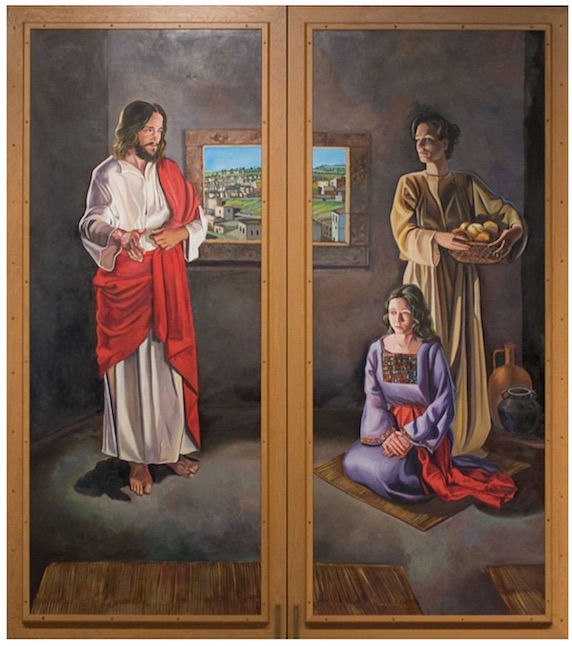
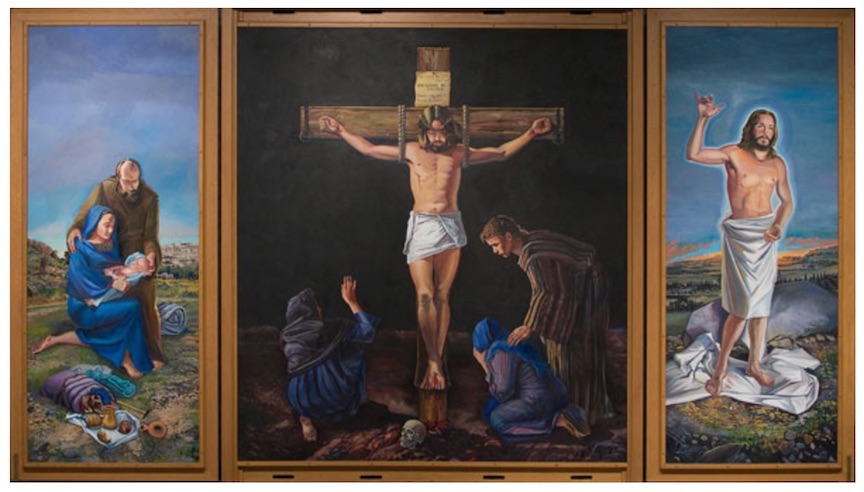
I chose a more traditional look. A year after I finished the altarpiece I was able to travel to the Holy Land and see some of the sites and people for myself. It didn't change my vision or idea of how Jesus should look. It made all of the paintings and images from history more real.
Recently I have been commissioned to paint a series of images for a small church in Minnesota. The church had been given a memorial and it was decided that it would go to commission artwork. With the pastor's leadership, they decided to have a Last Supper painting for the chancel wall near the communion rail in the altar area of church. They already had an altarpiece with sculpture. I gathered some young men and posed them for the Last Supper. It is hard not to be influenced by Leonardo da Vinci's famous version even though it is not considered historically accurate. Reclining in a Roman style of eating, just isn't very pictorially satisfying and the audience understands what you are trying to communicate. It is a very complex and difficult image to convey.
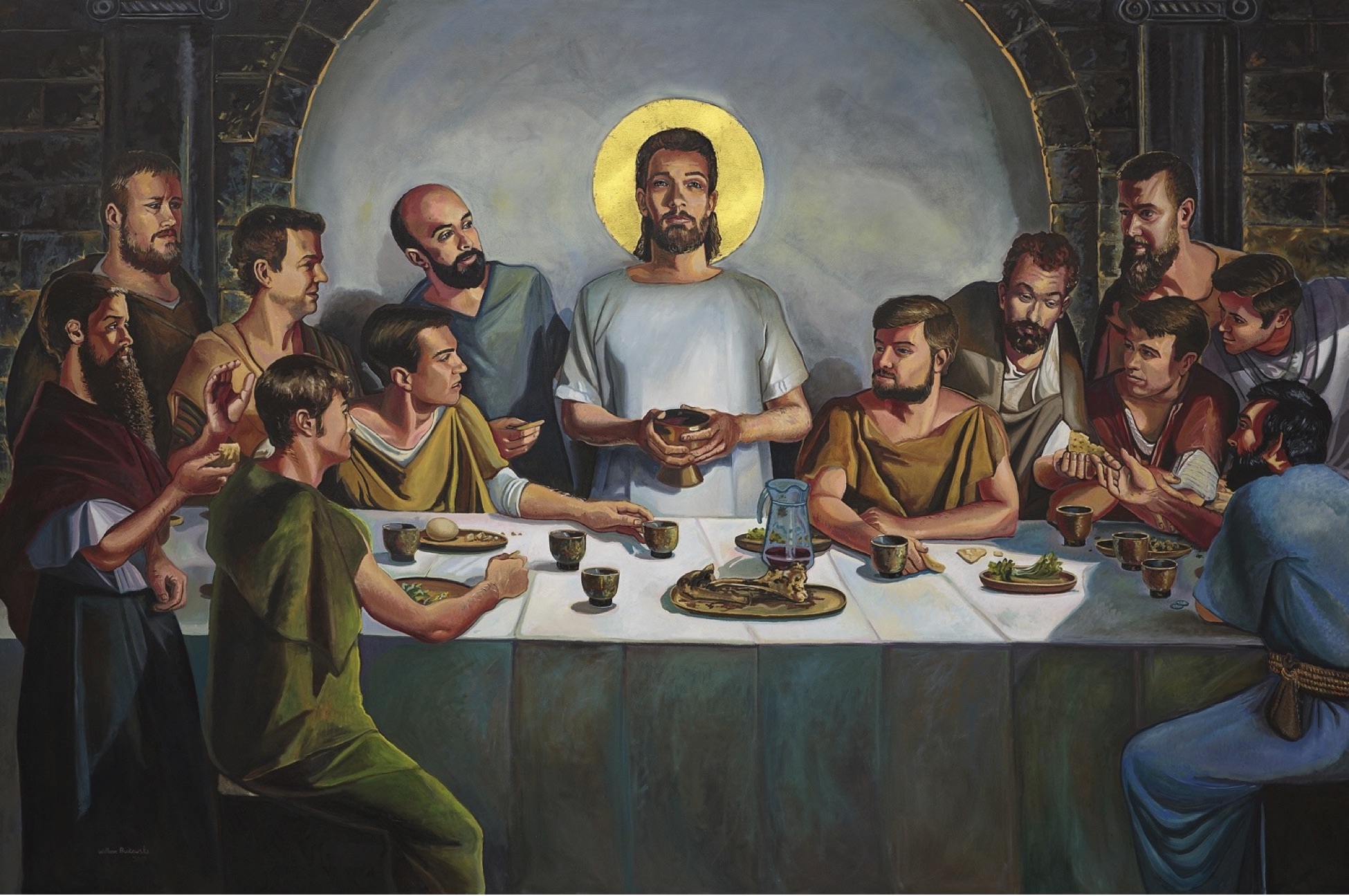
The congregation responded so well it gave the pastor the freedom to suggest a series on the life of Christ. I was commissioned again by the congregation with a vision for a series of eight paintings to be hung in the nave of the church.
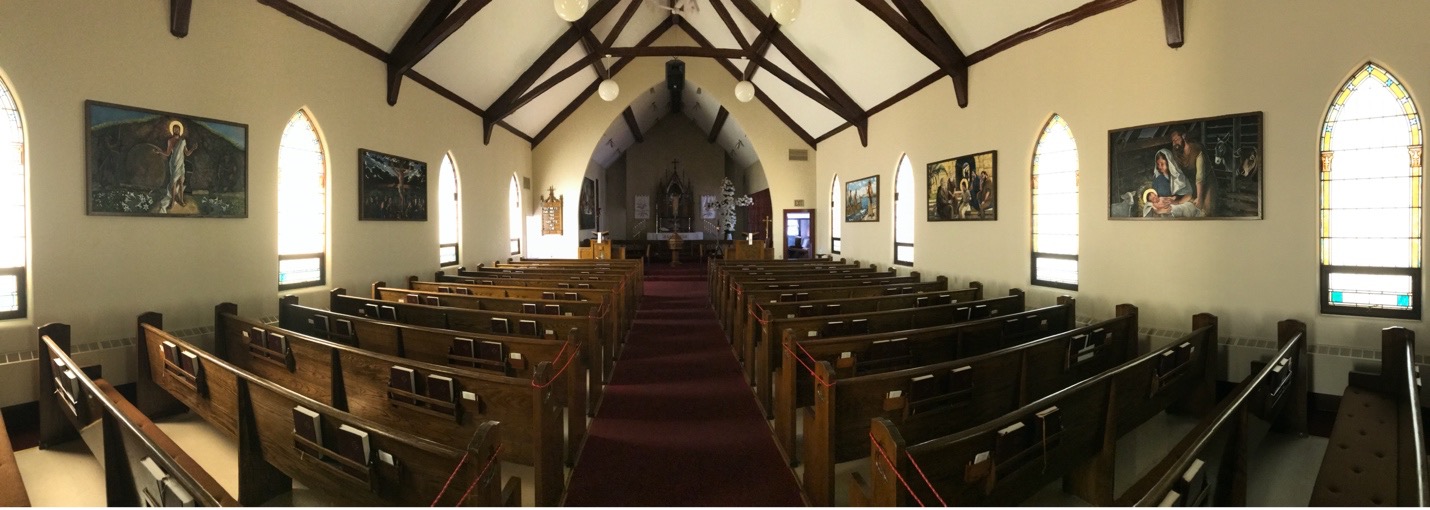
The next painting was the Resurrection. It is so difficult to imagine such an event and the pastor and congregation understood that as art, it is more of a symbol to evoke the memory of the readings in the Bible. I had asked if the church wanted to use the ancient designation of a gold leaf halo to identify Jesus. I also liked the idea of using symbols of rebirth and hope like the lilies in the foreground.

The next painting was the Nativity. I had been to Venice recently and had seen a Tintoretto painting of the nativity with wood slats that showed the sky and landscape. I really liked that idea. I also added the donkey and ox to illustrate Isaiah 1:3, "The ox knows his master, the donkey his owner's manger." The lamb was added to remind the viewer that Jesus is the lamb of God and the staff for the good shepherd.

After that painting came the Crucifixion. In some ways this is the most difficult because not many people want to look at such a revolting Roman death scene. I wanted to depict the moment when the sky was going dark and the pain was paramount. There is scattered light and an indifferent crowd. The dramatic sky is matched with the pain expressed in the curling toes of Jesus on the cross.

With each painting coming nearly six months apart, the excitement from the congregation grew. Money had been received from families either through donations or memorials. It was decided that Jesus in the Temple would be the next painting. I needed to show a young Jesus in a setting with theologians engaged in discussion. I wanted each man to show a different reaction to the young boy. I also had the idea to include Mary and Joseph in silhouette in the tunnel as a way to complete the narrative.

Jesus gathering his first disciples allowed for me to paint a landscape from the region. I needed fresh images of the Sea of Galilee, typical boats and models I had used in the Last Supper. The splashing water was particularly exciting to add motion to the painting.
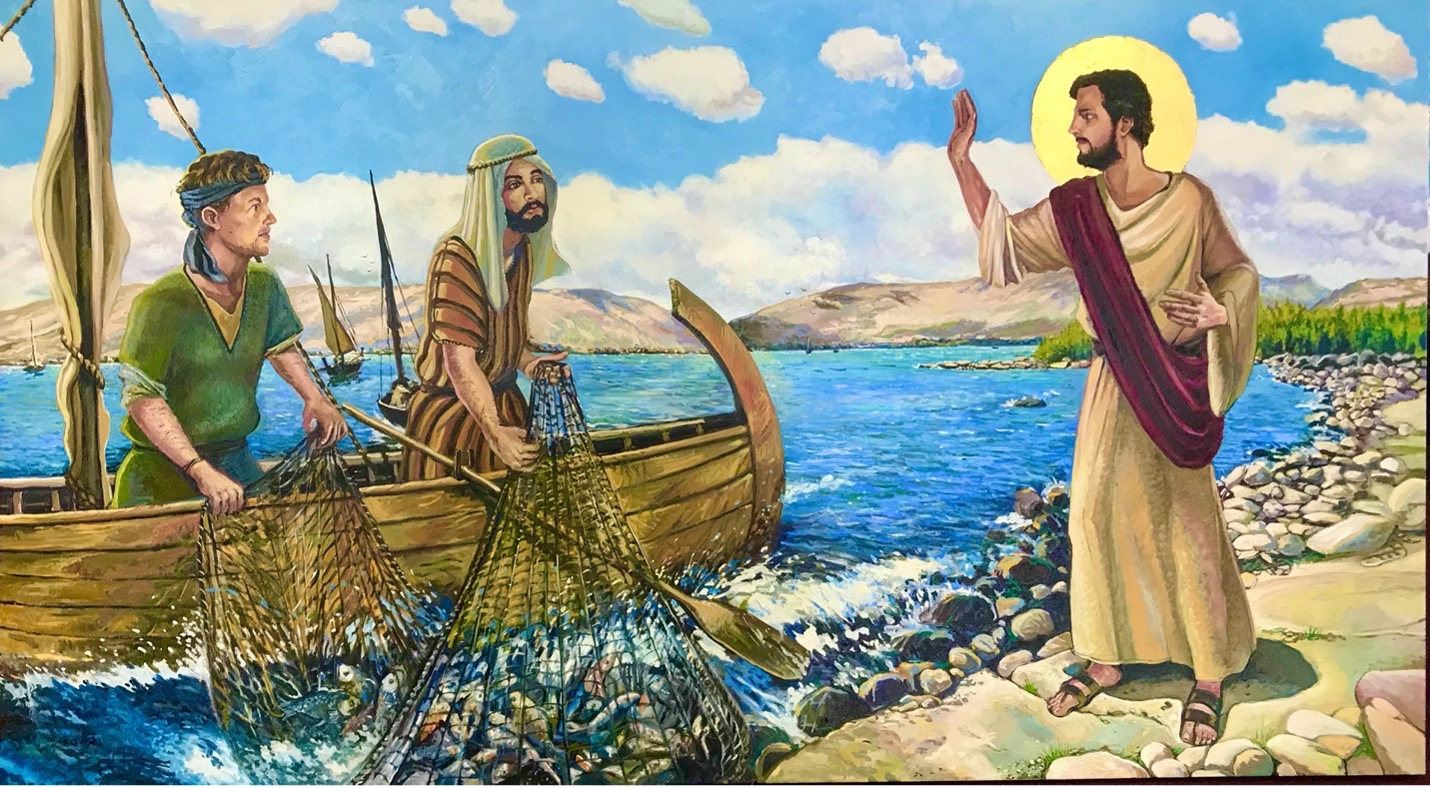
With the Ascension there was a special request. It should be based upon their altar piece sculpture in the front of the church. That sculpture has a special place in the history of the congregation as it was in the church when it was founded.

The project is ongoing. I am currently working on the Transfiguration. With each of these paintings I am trying to provide the narrative of the life of Christ in a way that will reassure the congregation every time they come to church. The paintings are fixed and unchanging as the truth of Christ's life and death on the cross and resurrection and ascension are fixed and unchanging. Generations of congregation members will come to this church with a sense of ownership in the visuals that direct their thoughts and comfort them in the truth of the Gospel.
Each time I receive a commission to paint Jesus I feel truly blessed with the opportunity to use my art to help further the truth of our salvation through Jesus Christ.
Return to original language with "show original" button at top left.

Discussion
Seeing your paintings on the walls of that small church in Minnesota reminded me of just how much I appreciate modern art within church walls. As much as I adore early artwork from the Renaissance and Medieval era, something is comforting about seeing Christian art being made in the present; it’s a breath of fresh air from the dust collecting on old depictions of Christ on Palm Sunday.
While seeing your art and its impact on those who ask for commissions, I was curious about how you came to accepting the commissions and developing a composition. Are there any commissions you turn down due to doctrinal differences, artistic differences, economic differences, or anything else of this matter? I would assume many of these have no effect on your paintings, as, like you said, these works are fixed and unchanging, just like the verity of Christ’s life, death, resurrection, and ascension.
Your work has genuinely altered my view on the popularity of Christian artwork in modern society. I thank you for sharing your art with the members of your own church and others as well. With all sincerity, I hope you continue to share the gospel and use your God-given gifts through commissions for many years.
Once I did the altarpiece at Bethany in 1996 I thought many ELS or WELS churches would be interested in my work. Unfortunately that was not the case. Conservative church bodies are also conservative about their church interiors and it is a kind of "leap of faith" to commission a local artist. It happens, but not as much as it should. I have never had to worry about doctrinal differences and I try to work within the budget of the church. I'm glad you enjoyed the article, now you have to see the artwork in person.
As someone who deeply enjoys painting, sketching, calligraphy, and all forms of art, I just want to say that I thoroughly enjoyed what you wrote as you took the reader through your journey of painting the different areas of Christ’s ministries. Sometimes the visual arts can be overlooked, but not unappreciated. I find your attitude regarding your gifts to be pleasing as well — I struggle sometimes with acknowledging my gifts in art since it can be difficult for me to feel like I’m not giving glory to God but rather to myself. Serving His kingdom through glorifying God in your artwork is a great approach!
After viewing your presentation, I did have a question as well. I was wondering, at the beginning of your presentation you’d presented the question regarding what kind of Christ you wanted to represent — a European-esque Christ an Arabic Christ, or some kind else? You’d mentioned that you were partial to the classic European style of Christ due to the artworks that had influenced you by various artists. I was wondering, does it matter which race Christ is represented as? Are we to depict him how the members of our church appear to look or perhaps how which race he truly was? It’s natural for us to want to create Him in our own image and likeness in the sense of appearances. However, is this just regarding preferences or does it take into account the viewer? Just curious!
Thank you so much for your presentation on how you represented and used your gifts of artwork in your church. Hopefully I will be able to continue serving in this same way.
I recall that this came up last year in the GOWM discussions. It was really thought provoking. You should check it out here: https://2020.gowm.org/sessions/bukowski/
I personally enjoy art in the church. It’s fascinating to see multiple versions and depictions of Jesus and his disciples in our churches today. Every artist has a different style, and that is certainly what makes art unique. I applaud you for your work to beautify this church with your art. I also liked the symbolism that you displayed in each painting, like the lilies or the lamb. It certainly adds to each painting, signifying God’s love for us.
After reading your descriptions of each piece and studying your paintings and how they differ from other artists’ work in the church, I had one question. You mentioned many artists and their paintings that you were most fond of early on in your life. And from those artists, you created your own unique style that might be similar but yet different. What led you to ultimately decide which style you liked best and the style you would use for your paintings of Jesus throughout his life? I like how you used bright yet almost calming and smooth colors to depict the emotions expressed in each event of Jesus’ life.
Thank you for sharing your paintings and how you use your gifts in the church to praise Jesus.
I have always been an avid fan of art history and have had many travel opportunities. I love art museums, ancient and historic churches and Christian art. As an artist, everything you see, and read about and think about is filtered through you. When you finally pick up the brush, things happen.
I am amazed by the talent displayed in your pieces! In my Fine Arts class here at Martin Luther College, we have been studying the artists Da Vinci, Tintoretto, etc. and the different styles of art used so I was delighted to hear how they impacted you specifically. Not only that, but how you have found great joy in completely various pieces depicting Jesus' life. It was fascinating to hear that you were able to travel to the Holy Land and Venice, which I’m sure as an artist was a breath-taking, surreal experience. It is so wonderful to hear the impact you have had on so many people, specifically the congregation of the church you have constructed multiple pieces for!
In this Fine Arts class that I mentioned, we have been delving into the different eras and ways artists carried out their paintings. I was specifically intrigued that Leonardo Da Vinci had to keep Mona Lisa entertained by jesters while painting her. I found it very intriguing that you prefer to work from life! Since you have people model for your paintings, do they pose for long periods of time or do you get the framework for the piece and let them go? How long does it usually take you on a single painting? This is so interesting to me, not only because studying art has been new to me, but also because I wanted to know how painting from life works in modern times.
Thank you for using your wonderful gifts to glorify the Lord!
I prefer to work from life, but with commissions I have had to take reference photographs of the models. I still seek out a model, find a costume, light it to my design and take the photos. It would be cost prohibitive to pay models to pose. It would be ideal, but very expensive.
I still paint as much as I can from life, but usually landscapes. With the first Jesus painting mentioned in the article, I did have a cross built and the model tied to it for the reference photos.
Thank you for your piece about a church’s uses for art in today’s age. This was interesting for me because the school connected to my home church congregation commissioned an artist to paint Jesus. This was when I was going to school there, so at least 6 years ago, probably more. In the auditorium of that school, we had a painting of Jesus, but decided it was time for a new one, so we commissioned an artist, who painted a scene of Jesus as the Good Shepherd, but in the background, you could see the gate was open, symbolizing how we stray from our Caregiver.
Something that I have always wondered about when seeing paintings of Jesus is the skin tone. I usually see artists having portrayed Jesus as caucasian, maybe more tan than the average American. Yet I know that he was from Bethlehem, which is in the Middle East. How much do you take ethnicity into account when painting scenes of Jesus and those around him?
Thank you for sharing your experiences about painting Jesus with all of us; I enjoyed reading about your art. God’s blessings.
It is true that many images of Jesus appear to be caucasian. It is also true that not everyone from Israel has darker skin. I do think the familiar images of Jesus with lighter skin really came from the Italian Renaissance and that was probably based more on the models who were available. They weren't thinking of the paintings as documented facts. Many of the early Greek Orthodox images show Jesus with darker skin, but ones coming out of Rome and Constantinople in the 5th century and beyond tended to be lighter.
I love your art. I can see how closely you paid attention to detail. When I was in high school, I started to learn more about appreciating art. Now in college, I still carry this appreciation with me. I love painting and crafting all the time. It was interesting to hear about your journey and your love for painting Jesus.
After reading your article, I had a few questions. I am always interested in learning the artist’s process. It fascinates me to find out new and unique information about an artist’s work. My first question is: How long does it typically take you to paint one artwork in order to provide the narrative of the life of Christ? Whenever I am drawing or painting something, it usually takes me a while. I wonder how long it takes someone who is not an amateur artist to complete a piece. One other question I had was about your process. How do you plan out your next painting? Do you take a look at a few different passages in the Bible? Do you reread the Bible story you are depicting? I know you said that you look at other artists’ depictions of specific Bible stories, but do you look at more than just their works? I really enjoyed taking a closer look at your works and hearing about your love for painting Jesus.
Thank you for taking the time out of your busy schedule to write this interesting article. I learned so much about the challenges of painting someone we’ve never seen in person.
The paintings I've featured in this article each took about 6 months to complete. I don't work on them exclusively or everyday. I began the series when I was a full time professor at Bethany. Now I am retired but I have other paintings I'm working on and other life events that take time from the studio. It is hard to calculate hours because it is the combined experience of years of painting that makes some of it easier and my goal to produce "good" or "memorable" art makes some of it harder. Each painting is planned out with thumb nail sketches and watercolor. I send them to the pastor for approval and then I send updates to the pastor. It is always shared with the congregation and approved by a church council. I always read the passages that i am painting and I like to see how other artists have solved the artistic problem. The time frame that I've used is comfortable because I don't want to rush them, but there have been times when working on several commissions at once that has been very difficult and distracting.
Since I was young I have always been interested in art. I love to paint and draw. I love how you talked about your art in a way that is helpful for evangelism. Through art we can proclaim the gospel message in many ways. Each time you described one of your paintings I became more interested in what you had to say. In particular the painting you did of Jesus in the temple. This painting had a lot of depth and meaning to it. I love how you mentioned that each of the men's faces had a different reaction to Jesus' proclamation. Not only this, but you included Mary and Joseph in the back and I think that was an important detail to the story.
I am curious about what got you started on this journey. Have you always loved art from a young age? Is this something you always pictured yourself doing? Sometimes God surprises us with what happens to us in life. And I am amazed by your story and would like to know a little bit about your background in art and painting.
Because I can connect with you on how much art is prevalent in our lives, I thought it was very interesting to read. It has made me think of new ways I am able to spread God’s word. Thank you for your efforts and talking about your story.
I distinctly remember thinking I was an artist at age 5. I enjoyed drawing and painting and was told that I was pretty good at it. As a grade school student I loved comic books and wanted to become a comic book artist. I especially liked the Marvel heroes and copied them throughout high school. In college I went on a trip to Italy and it changed my artistic goals. I didn't think comics were serious enough, and I wanted to become part of the tradition of great European painters. I especially liked Titian, Rubens and Michelangelo in those early days. My interest in comics had given me a love of narrative art and the figure painters of Europe had the great themes- especially the life of Christ. As a realist painter I did many portraits, still life and landscape paintings that prepared me to painting anything, When the opportunity for the commissions came along, I was ready.
There is so much talent shown through your pieces! It is very interesting to see the multiple different displays of Jesus and his disciples. I have so much appreciation for art and it was very cool to hear about your story and your paintings.
After reading your article, I am curious about what got you started on this journey. Have you always loved art? Did you paint at a young age? Did it take you a long time to complete your work? I really enjoyed hearing about your journey and looking at your work!
Thank you for sharing your story and spreading God’s word through your work!
A couple of your questions I've answered in earlier posts. I think it is important for an artist to declare themselves an artist. I know that sounds too easy but once you decide to become an artist, you make decisions in life based upon that idea. That is pretty much what I did. I started oil painting in college and felt God's hand in my career path. When I was in graduate school (in Madison, Wisconsin) one of my classmates asked me what I thought I would do after grad school and my reply was, "I will probably work at a small college where my wife went to school (Bethany Lutheran College). Lo and behold, I ended up teaching and painting at Bethany for 40 years.
I have always been a student of art history. I love experiencing great art first hand and seeing it for myself. When I have studied works of art that are considered masterpieces, I have found that they always have complex meanings interwoven into the images. Often these meanings are lost on the average contemporary viewer but they were clear at the time the painting was completed. So I hope to pay homage to the traditions of meaning in art, especially Christian art.
I really took to heart your passion and interest in trying to truly capture Jesus and biblical gospel truth into a painting. I enjoy art and painting and find joy in what it can do to yourself and to other people. I found most interesting how you found people to help model your vision of what Christ looked and appeared to others.
I really found it fascinating how much time and effort you spent doing research to find the best method to show and display history accurately. You also talked about how you tried to avoid not copying other artists like Leonardo Di Vinci for example. What was the best way to be able to incorporate your personal touch into the art piece, while also making sure to remain historically and biblically accurate?
I really appreciated looking at your art and how it impacted the church. Your God-given talents are being used in a very helpful way to spread the gospel.
I think every artist eventually develops a style. Each artist uses paint in a particular way and uses all of the elements of art to create their style. So for an artist, the best way to develop that style is to do a lot of artwork. One must try different approaches to find what works best for you. As an artist, you continually develop based on experience, age and insight and possibly talent. It is a big commitment to be an artist as it is a lifestyle and lifetime vocation. The question of being accurate and still working within your style is trying to understand your audience and making sure they know what you are communicating.